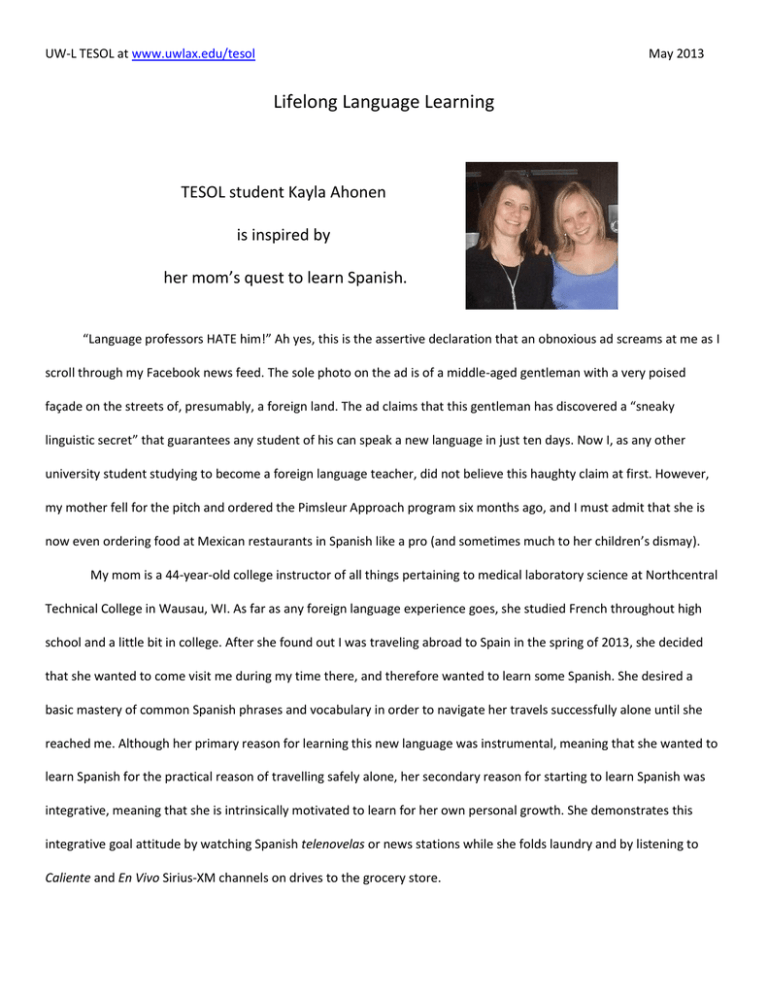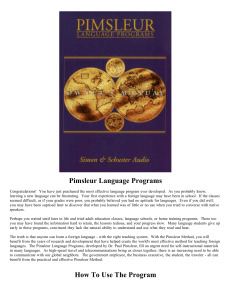Lifelong Language Learning TESOL student Kayla Ahonen is inspired by
advertisement

UW-L TESOL at www.uwlax.edu/tesol May 2013 Lifelong Language Learning TESOL student Kayla Ahonen is inspired by her mom’s quest to learn Spanish. “Language professors HATE him!” Ah yes, this is the assertive declaration that an obnoxious ad screams at me as I scroll through my Facebook news feed. The sole photo on the ad is of a middle-aged gentleman with a very poised façade on the streets of, presumably, a foreign land. The ad claims that this gentleman has discovered a “sneaky linguistic secret” that guarantees any student of his can speak a new language in just ten days. Now I, as any other university student studying to become a foreign language teacher, did not believe this haughty claim at first. However, my mother fell for the pitch and ordered the Pimsleur Approach program six months ago, and I must admit that she is now even ordering food at Mexican restaurants in Spanish like a pro (and sometimes much to her children’s dismay). My mom is a 44-year-old college instructor of all things pertaining to medical laboratory science at Northcentral Technical College in Wausau, WI. As far as any foreign language experience goes, she studied French throughout high school and a little bit in college. After she found out I was traveling abroad to Spain in the spring of 2013, she decided that she wanted to come visit me during my time there, and therefore wanted to learn some Spanish. She desired a basic mastery of common Spanish phrases and vocabulary in order to navigate her travels successfully alone until she reached me. Although her primary reason for learning this new language was instrumental, meaning that she wanted to learn Spanish for the practical reason of travelling safely alone, her secondary reason for starting to learn Spanish was integrative, meaning that she is intrinsically motivated to learn for her own personal growth. She demonstrates this integrative goal attitude by watching Spanish telenovelas or news stations while she folds laundry and by listening to Caliente and En Vivo Sirius-XM channels on drives to the grocery store. After seeing an advertisement claiming that she could learn Spanish in as little as ten days back in March of 2012, my mom wasted no time and ordered the Pimsleur Approach. This language-learning program was developed by Dr. Paul Pimsleur, who holds a PhD in French and a Masters in Psychology with an emphasis in applied linguistics. He describes his approach as a “natural way” to learn a second language by simply “picking it up,” just as people when learning their first language as a child. The Pimsleur approach emphasizes acquisition over learning, suggesting that hearing how vocabulary and grammar flow together right away in common phrases is more effective than learning each concept separately and then attempting to piece them together, which is the way Spanish is taught, for example, in a traditional language classroom. A learner who utilizes Pimsleur’s method is presented with a sequence of half-hour audio lessons that feature native speakers engaged in simple conversations. A novice is not to be intimidated by the Spanish immersion though, as the voice of an English instructor offers limited guidance in each segment as to what the speakers are discussing. After hearing the conversation, the learner is offered numerous chances to verbally practice the new vocabulary and phrases they are hearing; and subsequent lessons review and build upon previous lesson topics. This technique is called gradual interval recall, which is discussed in an article written by Dr. Pimsleur himself in The Modern Language Journal in 1967. Here, he suggests that if a learner is asked to repeat new vocabulary each time the memory starts to fade, long-term retention of that vocabulary is more likely. The gradual decrease in frequency between times of recall will ultimately be more effective than “drumming in” new vocabulary all at once. Due to my mom’s choice of second language learning program, one of her primary learning strategies is metacognitive, which allows for self-direction of learning. A metacognitive learning strategy emphasizes the planning and organization of learning, which is vital when using a self-paced audio program such as the Pimsleur Approach. A learner must find the time to engage and participate in the lessons for a half hour per day for the majority of each week. My mom commutes to work, so she has a solid two hours in the car for at least four days a week during the academic year. Her commute is how she structures and manages her learning, since during this window is when she completes her Spanish lessons. Often times, she does two lessons in one day, one during the drive to work and one during the drive home. This window of time offers her privacy to practice out loud as much as much as possible, which is vital for learning any second language with any method. In addition to using metacognitive strategies to learn Spanish, my mom is also using socio-affective strategies, which emphasize interaction with others to assist learning. My brother has taken two years of German in high school, and my dad says he “knows German” (but his lone semester of German in college that earned a D begs to differ.) At any rate, since they don’t have any experience with Spanish, they are of no help to my mom in her second language learning journey. Luckily, the female side of the family seems to have the Español bone. I am in college studying Spanish and education, and now have more than seven years of Spanish classes, a semester in Spain, and a short stint abroad in Guatemala under my belt. My sister, who will be a junior in high school, has completed three years of Spanish classes. Through interaction with us, my mom is able to utilize socio-affective strategies, which include cooperation and questioning for clarification. My mom often starts conversations with us in Spanish and asks questions about how to say certain words, how to conjugate specific verbs, and how to pronounce Spanish sounds that she sometimes can’t distinguish clearly on the audio. Through the formal language instruction my sister and I have received in school, we are able to provide her with answers that she might not otherwise have been able to find alone. Through observation of my mom’s second language learning strategies, I am impressed that the Pimsleur Approach works so well and am even more so impressed by my mom’s recent progress in learning Spanish at a later age than most. I think her learning journey can demonstrate that traditional, formal instruction that emphasizes the “building blocks” of language first is not always necessary to become a speaker of another language. Sometimes, all a Spanish learner needs is desire, partial immersion to encourage acquisition, and time alone in a car to practice rolling her rrs without interruption. Note: This essay is adapted from an assignment Kayla Ahonen submitted in October 2012 as a requirement for a required course for her TESOL minor: TSL 400 Program Models for Second Language Acquisition. Appendix A Figure 1: Advertisement of Pimsleur Approach (Credit: <http://3.bp.blogspot.com/-ooWyuxFu7i0/T2OdidRtNFI/AAAAAAAACfE/eyb9ScXViI/s1600/pimsleur+ad%252C+language+professors+hate+him.png>) Bibliography "Learn Spanish Fast!" Pimsleur Approach. N.p., n.d. Web. 24 Oct. 2012. http://www.pimsleurapproach.com/learn-spanish/ "Pimsleur Method of Learning a Foreign Language." Simon and Schuster's Pimsleur. N.p., n.d. Web. 24 http://www.pimsleur.com/The-Pimsleur-Method Pimsleur, Paul. "A Memory Schedule." The Modern Language Journal 51.2 (1967): 73-75. Print. http://www.jstor.org/stable/321812 Zare, Pezhman. “Language Learning Strategies Among EFL/ESL Learners: A Review of Literature.” International Journal of Humanities and Social Science Vol. 2 No. 5 (2012): 162 – 169. Oct. 2012.





